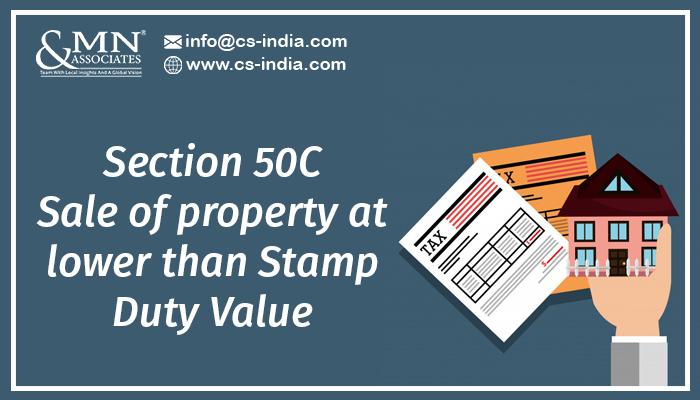
Section 50C – Sale of property at lower than Stamp Duty Value
There can be circumstances where a person has to sell out his property at a value lower than the fair market value. The government imposes a capital gain tax on all capital assets or immovable properties if they are sold at a price higher than the computed value by the valuation authorities i.e. at a price more than their stamp duty value.
To fairly predict and compute the value of a property, the government has prescribed circle rates/fair market value rates which are used by stamp duty valuation authority to estimate the value of the property.
Mostly, people try to save taxes by declaring the low value of their property than the estimated stamp duty value, but they are unaware of the penal consequences they have to face for doing such transactions.
In this post, you will get to know how the stamp duty value of the property is estimated by the department for tax purposes if property value declared by the taxpayer is lower than the fair market value.
Valuation of Property Sold/Transferred for Tax Purpose
Section 50C – Taxability of Capital Asset valued lower than actual stamp value.
For easy valuation and assessment of property transactions by government authorities, minimum circle rates for each property type-building or land is provided by the government. The circle rates differ from locality to locality and provide an estimation of the value of the property.
Properties are often sold at a price higher than the circle rates, but to save taxes and capital gains most taxpayers opt to show the lower value of their property then stamp duty rates. Section 50C provides tax treatment of all such transactions where the property is declared to be sold at a lower value.
As per this section, the value of the property will be estimated by stamp valuation authority by comparing – The circle rate with the value declared by the seller.
For tax purposes the following values will be considered as the value of the property:
- Stamp duty value < 105% of sale consideration declared by the seller of property. (Now, 110% for AY 2020-21, as amended in Finance Bill, 2020 ) = Value determined by the seller
- Stamp duty value > 105% = the Stamp duty value estimated by value estimated by valuation authority. ( Now 110% for AY 2020-21, as amended in Finance Bill, 2020 ) = Value estimated by Stamp duty valuation authority.
For instance, property under sale agreement is valued at Rs. 90 lakh by the seller, for the purpose of Calculation of capital gain the value of the property under Section 50C will be estimated in the following way :
- Property value estimated Rs 92 lakh by Stamp Duty Valuation Authority
Here, the value estimated by stamp duty valuation authority is 102% of the value declared by the seller as it is less than 105% (110% for AY 2020-21) the value declared by the seller shall be considered as the value of the property for income tax purpose.
- Property value estimated for Rs. 90 lakh by stamp duty valuation authority.
Here, the value estimated by the stamp duty valuation authority is 100% percent of the value declared by the seller. In this case, the value declared by the seller will be considered for value estimation.
- Property value estimated for Rs 1 crore by stamp duty valuation authority.
Here, the value estimated by stamp duty valuation authority is 111% of the value declared by the seller in this case the seller has undervalued his property. The valuation done by the authority will be considered in this case.
- Property value estimated for Rs. 85 lakh by stamp duty valuation by authority
Here, the value estimated by the stamp duty valuation authority is 94% of the value declared by the seller in this case the highest value will be considered which in this case is 90 lakh which has been declared by the seller.
In some cases, the seller of the property opposes the estimation of the stamp duty valuation authority, in such cases the value estimation is done by a valuation officer. The value so estimated by the valuation officer will be compared with the stamp duty valuation authority and the second-highest value will be chosen for the estimation of the value of the property.
For instance evaluation officer values the above property for Rs 96 lakh and the stamp duty valuation authority values it for Rs 1 crore then the value determined by the valuation officer will be considered for tax estimation.
Taxability of property in the hands of the buyer
Section 56 2(X) specifies for taxability of immovable property in the hands of the buyer if;
The consideration paid for such property exceeds the stamp duty value computed by stamp duty valuation authority Rs 50,000. It will be charged as Income from Other Sources. But to hold the property taxable in the hands of the buyer two conditions have to be met:
- The difference between the consideration and the stamp duty value of the property should be in excess of Rs 50,000.
- The excess amount should also be more than 10% of the consideration.
Note: The section also permits non-taxability of immovable property gifts received from relatives by a taxpayer.
If the property is sold by the seller at a lower value then the fair market value not as a capital Asset but as a stock in trade then provisions of Section 43CA shall be applicable.
Facing problem in tax estimation?
Talk to our direct tax experts at info@cs-india.com
